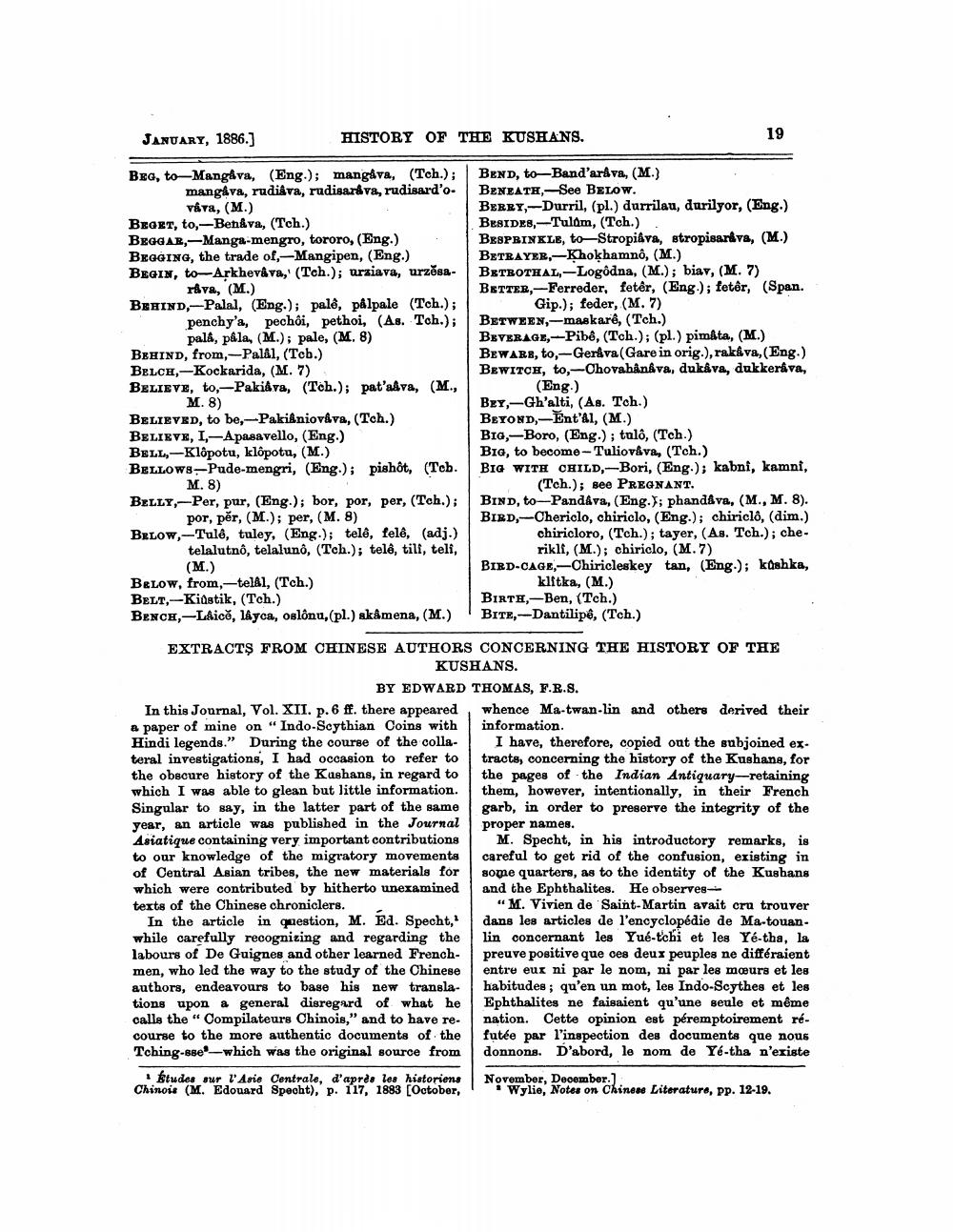________________
JANUARY, 1886.)
HISTORY OF THE KUSHANS.
19
BEG, to-Mangåva, (Eng.); mangåva, (Tch.);
mangava, rudiâva, rudisaráva, rudisard'o.
váva, (M.) BEGET, to,-Ben&va, (Tch.) BEGGAR,-Manga-mengro, tororo, (Eng.) BEGGING, the trade of,-Mangipen, (Eng.) BEGIN, to-Arkhevâva, (Tch.); urziava, urzose
riva, (M.) BEHIND,-Palal, (Eng.); palo, pålpale (Tch.);
penchy'a, pechôi, pethoi, (As. Tch.);
palá, påla, (M.); pale, (M. 8) BEHIND, from, --Palal, (Teb.) BELCH-Kockarida, (M. 7) BELIEVE, to,-Pakiâva, (Tch.); pat'alva, M.,
M. 8) BELIEVED, to be,Pakiiniováva, (Tch.) BELIEVE, I,-Apasavello, (Eng.) BELL,-Klopotu, klopotu, (M.) BELLOWS--Pude-mengri, (Eng.); pishôt, (Teb.
M. 8) BELLY,-Per, pur, (Eng.); bor, por, per, (Toh.);
por, pěr, (M.); per, (M. 8) BELOW,-Tule, tuley, (Eng.); teló, fele, (adj.)
telalutno, telaluno, (Tch.); telê, tili, teli,
(M.) Below, from,-tel&l, (Tch.) BELT,-Kidstik, (Tch.) Bench,-LAică, lâyca, oslonu, (pl.) skåmena, (M.)
BEND, to-Band'aráva, (M.) BENEATH,- See BELOW. BERRY,-Durril, (pl.) durrilau, durilyor, (Eng.) BESIDES, -Tulom, (Tch.). BESPRINKLE, to-Stropikva, stropisarkva, (M.) BETRAYER,-Khokhamnô, (M.) BETBOTHAL,-Logodna, (M.); biav, (M. 7) BETTER,-Ferreder, fetêr, (Eng.); fetêr, (Span.
Gip.); feder, (M. 7) BETWEEN,-maskarê, (Tch.) BEVERAGE ---Pibê, (Tch.); (pl.) pimåta, (M.) BEWARE, to,-Geriva (Gare in orig.), rakkva,(Eng.) BEWITCH, to,-Chovahânâva, dukáva, dukkeráva,
(Eng.) BEY,-Gh'alti, (As. Tch.) BEYOND,-Ent'Al, (M.) BIG-Boro, (Eng.) ; tulo, (Tch.) BIG, to become-Tulioviva, (Tch.) BIG WITH CHILD,-Bori, (Eng.); kabni, kamni,
(Tch.); see PREGNANT. BIND, to-Pandáva, (Eng.); phandava, (M., M. 8). BIRD,-Chericlo, chiriclo, (Eng.); chiriclo, (dim.)
chiricloro, (Tch.); tayer, (A.s. Tch.); che
rikli, (M.); chiriclo, (M.7) BIRD-CAGE, -Chiricleskey tan, (Eng.); koshka,
klitka, (M.) BIRTH,-Ben, (Tch.) BITE-Dantilipê, (Tch.)
EXTRACTS FROM CHINESE AUTHORS CONCERNING THE HISTORY OF THE
KUSHANS.
BY EDWARD THOMAS, F.R.S. In this Journal, Vol. XII. p. 6 ff. there appeared whence Ma-twan-lin and others derived their a paper of mine on "Indo-Scythian Coins with information. Hindi legends." During the course of the colla- I have, therefore, copied out the subjoined ex. teral investigations, I had occasion to refer to tracts, concerning the history of the Kushana, for the obscure history of the Kushans, in regard to the pages of the Indian Antiquary-retaining which I was able to glean but little information. them, however, intentionally, in their French Singular to say, in the latter part of the same garb, in order to preserve the integrity of the year, an article was published in the Journal
proper names. Asiatique containing very important contributions M. Specht, in his introductory remarks, is to our knowledge of the migratory movements careful to get rid of the confusion, existing in of Central Asian tribes, the new materials for some quarters, as to the identity of the Kushans which were contributed by hitherto unexamined and the Ephthalites. He observes-- texts of the Chinese chroniclers.
"M. Vivien de Saint-Martin avait cru trouver In the article in question, M. Ed. Specht, dans les articles de l'encyclopédie de Ma-touanwhile carefully recognizing and regarding the lin concernant les Yué-t'chi et les Yé-tha, la labours of De Guignes and other learned French- preuve positive que ces deux peuples ne différaient men, who led the way to the study of the Chinese entre eux ni par le nom, ni par les meurs et les authors, endeavours to base his new transla. habitudes; qu'en un mot, les Indo-Scythes et les tions upon a general disregard of what he Ephthalites ne faisaient qu'une seule et même calls the "Compilateurs Chinois," and to have re. nation. Cette opinion est péremptoirement récourse to the more authentic documents of the futée par l'inspection des documents que nous Tching-sse which was the original source from donnons. D'abord, le nom de Yé-tha n'existe
Studes sur l'Asie Centrale, d'après les historiens Chinois (M. Edouard Specht), p. 117, 1883 [October,
November, December.).
Wylie, Notes on Chinese Literature, pp. 12-19.




